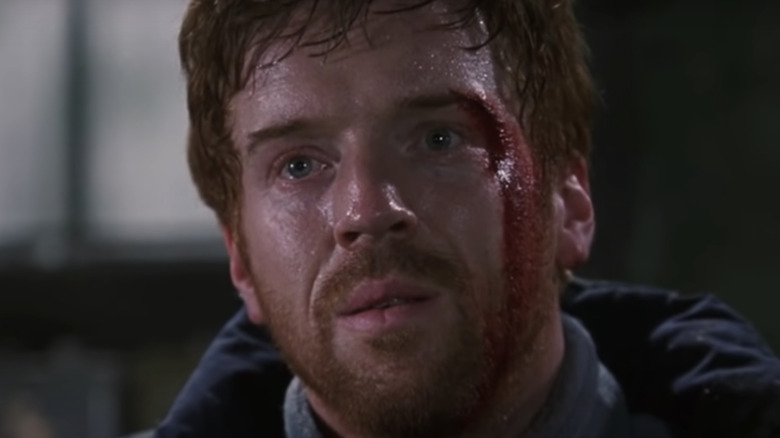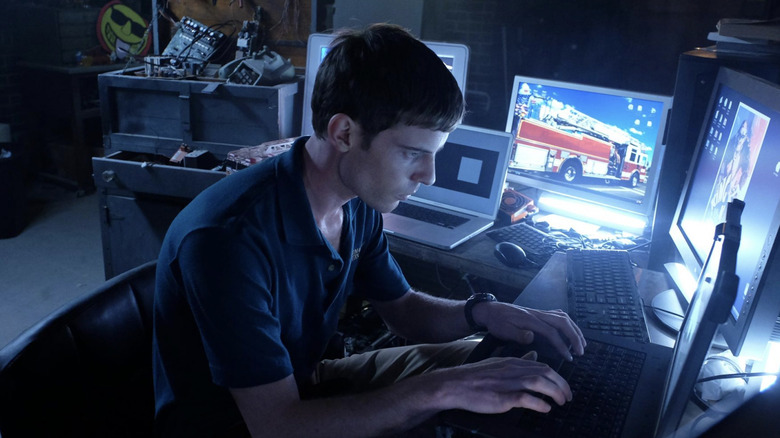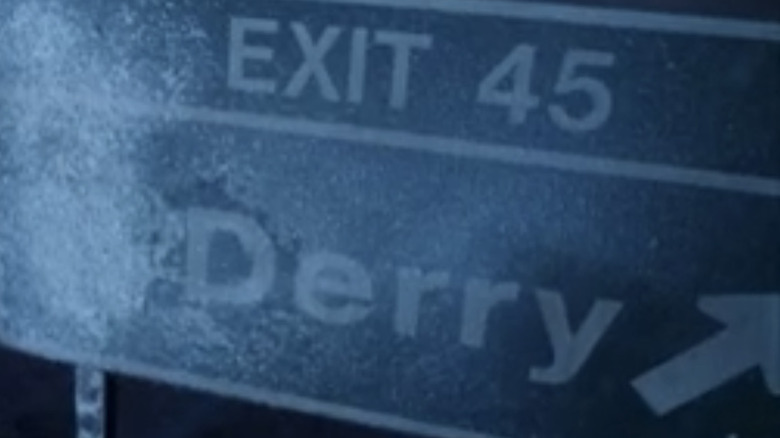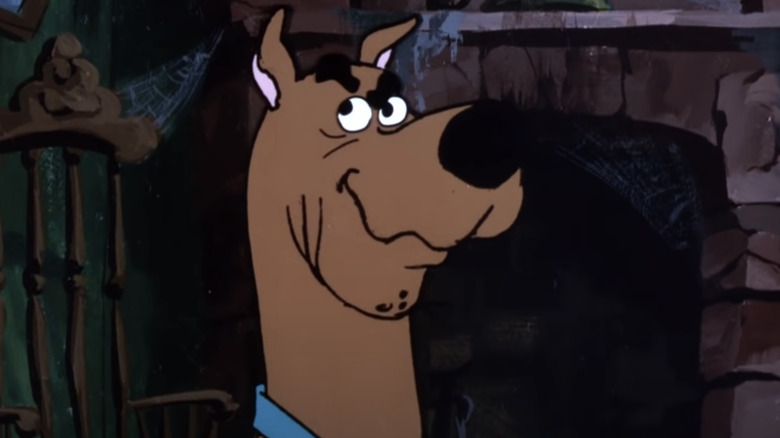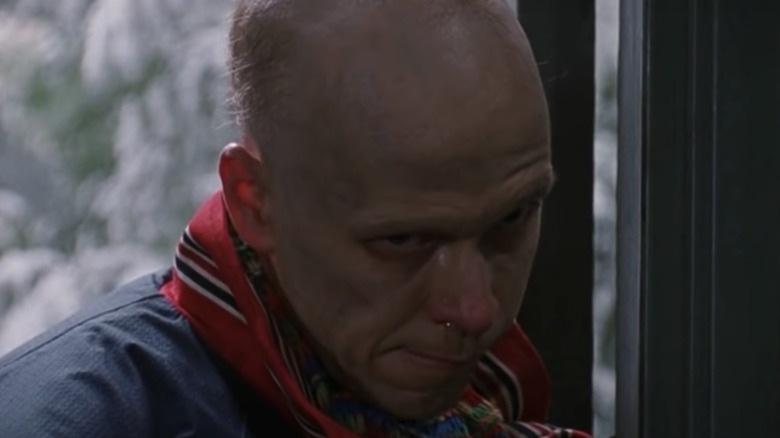The Ending Of Dreamcatcher Explained
The only thing more challenging than breaking down the ending of "Dreamcatcher" is probably putting it together in the first place. It's a task that the creator of this story comprised of space slugs and animated Great Dane idolization admits did lose its way a tad. In an interview with Rolling Stone, master storyteller Stephen King revealed that after "The Tommyknockers," "Dreamcatcher" was his least favorite book because he was recovering from a near-fatal car accident and was on prescribed Oxycontin at the time of writing. "I was pretty stoned when I wrote it because of the Oxy, and that's another book that shows the drugs at work," he admitted.
Nevertheless, Hollywood snatched up this botched book to bring to life with Lawrence Kasdan directing, using the talents of Morgan Freeman, Tom Sizemore, and "Band of Brothers" stars Donnie Wahlberg and Damien Lewis to help it along. The film followed four friends, all bound by a fifth (Wahlberg) they rescued in childhood, who then blessed them with special powers. These gifts come in handy when they find themselves in the middle of an alien invasion during a reunion years later. Unfortunately, it's still not enough as their group loses two members at the hands of Mr. Gray, an otherworldly being that the remaining pals face off against to save the planet, in what is the most 2000s-CGI showdown ever to come out of Derry, or not far off from.
A Dreamcatcher character has Mr. Mercedes connections
After offing Beaver (Jason Lee) and Pete (Timothy Olyphant), it's left to two of the original friend group to uncover and stop Mr. Gray's (now inhabiting Jonesy) plan. It's a plot point with Damien Lewis working double-time as Jonesy and his symbiotic invader, Mr. Gray, leading to a cerebral confrontation. While Mr. Gray is piloting Jonesy's body, his consciousness is still fighting from a mental fortress he calls his Memory Warehouse, which resembles an enormous library. It's also a safe spot for Jonesy to contact his remaining friends telepathically, reaching beyond his own body from inside his mind. For fans of King adaptations that took place after this, it's a similar tactic applied by another character in a trilogy of books from the writer that made its way to television from the trunk of a blood-stained Mercedes.
In 2019, Audience's now-shut-down channel adapted "Mr. Mercedes," which saw a seasoned detective track down a serial killer whose previous weapon of choice was a stolen car. During its 2nd season, the show's psychotic villain Brady Hartsfield (Harry Treadaway), is in a coma after failing to enact another rampage but can observe and interact with the outside world psychically from a mental construct modeled on his basement. It's an interesting link, particularly given the 14-year gap between Lawrence Kasdan's film and the Brendan Gleeson-starring series, and another excellent head trip for an equally gifted character, even if he uses them for the wrong reasons.
Derry is the IT place to home Dreamcatcher's finale
After checking in with Henry (Thomas Jane) from his brain-based warehouse, Jonesy reveals Mr. Gray's plans to infiltrate a water reservoir for his alien invasion, and that their old pal, Duddits (Donnie Wahlberg) from back home, is key to stopping it. The interesting thing about their childhood turf is that it happens to be the same one King has often visited in his books and has earned the most notoriety by way of a killer clown that recently returned to cinemas after some 27 years.
King fans will know that Derry is also where Stephen King's beloved horror classic, "IT," took place. That book's villain, Pennywise the Clown (played by Bill Skarsgard in the recent films), is not mentioned in the "Dreamcatcher" adaptation. However, in the book, Mr. Gray heads to It's feeding ground to poison the water there, instead of Massachusetts like in the film. It's there he sees a plaque dedicated to those lost in a flood that occurred during the Losers Club's final battle with Pennywise. The slightly concerning issue is that the memorial is marked in graffiti with the message, "Pennywise Lives!"
While there's no sign of the clown in this film (thankfully) or mention of the other gang of kids from the town, it's an interesting detail that King's quaint little spot with lots of history, also was home to many children that grew up to be heroes in their own right.
The Dreamcatcher mystery is solved in the link to Scooby-Dooby Doo
After reaching the water reservoir to stop Mr. Gray, things quickly turn south and slug-like. Henry is out of ammo against the foe that looks like his friend, and the future looks bleak. Thankfully, in steps Duddits, armed only with winter boots, a Scooby-Doo swag to turn the tide. "Ooby Dooby-Doo...we've got some work to do now," he says before revealing that he has been another species of alien in disguise this whole time, waiting to face off against Mr. Gray. While it's not the most fantastic scrap between space beings caught on film, it's fitting that it's sparked from a revelation that links to Duddits' favorite cartoon dog.
Since 1969, the MO for Scooby-Doo has been taking on an elusive monster, only to learn that it's someone in a costume. Coincidentally, this very same tactic is applied in the final act of "Dreamcatcher," with the most underestimated member of the group taking off the villain's mask to reveal the true identity underneath. The only difference here, of course, is that we get it in reverse, and the man suit is ditched to reveal a blob that is two evolutionary steps down from the bug in "Men in Black." It's a fairly fitting end for Duddits' character, whose last remains form the shape of a dreamcatcher, which Duddits made for his friends as a boy. It's just a shame that the alternative ending wasn't used instead.
The original Dreamcatcher ending was a lot less dramatic but made a lot more sense
It's clear that, for its time, the final scene of "Dreamcatcher" went as epic as it could. After a helicopter showdown, Henry and Jonesy sit back in awe as what looks like two video game bosses merge into one before exploding into dust. While it might've wowed audiences back then, the disappointing thing is that the original ending was a lot more simplistic. It also made a lot more sense (via YouTube).
Originally, "Dreamcatcher" ended with Duddits, still in human form with no indication that he's from another planet, using his powers to beat Mr. Gray and turn him into the red mist to save the day. It's his final act of heroism before dying soon after following his battle with leukemia. A flash-forward shows Henry and Jonesy visiting his grave, where the two sing their fallen friend's favorite song in tribute. While it's not as extravagant as what was shown in theatres, it tied things up in a logical way and showed our hero succumbing to his illness. Also, like the official ending, it didn't have us asking how his mother, who had tended to her son for years with his condition, did not know that he was, in fact, an insect from another planet. Stephen King sure has penned some wild endings, but the finale of "Dreamcatcher" is still one that might've been better off with the first draft.
